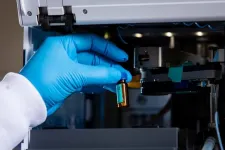(Press-News.org) Doctors around the world may soon have access to a new tool that could better predict whether individual cancer patients will benefit from immune checkpoint inhibitors — a type of immunotherapy — using only routine blood tests and clinical data.
The artificial intelligence–based model, dubbed SCORPIO, was developed by a team of researchers from Memorial Sloan Kettering Cancer Center (MSK) and the Tisch Cancer Institute at Mount Sinai.
The model is not only cheaper and more accessible, it’s significantly better at predicting outcomes than the two current biomarkers approved by the U.S. Food and Drug Administration (FDA), according to findings published January 6 in Nature Medicine.
“Immune checkpoint inhibitors are a very powerful tool against cancer, but they don’t yet work for most patients,” says study co-senior author Luc Morris, MD, a surgeon and research lab director at MSK. “These drugs are expensive, and they can come with serious side effects.”
So the key is patient selection — matching the drugs with patients who are most likely to benefit, Dr. Morris says.
“There are some existing tools that predict whether tumors will respond to these drugs, but they tend to rely on advanced genomic testing that is not widely available around the world,” he adds. “We wanted to develop a model that can help guide treatment decisions using widely available data, such as routine blood tests.”
Collaborating to Make Checkpoint Inhibitor Therapy Work for More Cancer Patients
Checkpoint inhibitors target the immune system rather than the cancer itself. These drugs work by taking the brakes off immune cells, allowing them to better fight cancer. MSK clinicians and scientists played a key role in bringing the new class of drugs to patients.
The new study was jointly overseen by Dr. Morris and Diego Chowell, PhD, an Assistant Professor of Immunology and Immunotherapy, Oncological Sciences, and Artificial Intelligence and Human Health at the Icahn School of Medicine at Mount Sinai, and a former postdoctoral fellow at MSK.
Q&A with Dr. Morris
We spoke with Dr. Morris about the team’s prediction model and next steps for the research:
Why did you develop this new model to predict checkpoint inhibitor response?
It was clear there was room for improvement.
There are currently two FDA-approved biomarkers for predicting response to checkpoint inhibitors: tumor mutational burden (the number of mutations in a tumor) and PD-L1 immunohistochemistry (evaluating the expression of the programmed death-ligand 1 protein in tumor samples).
Both require samples of the tumor to be collected. Meanwhile, genomic testing to assess mutations is expensive and not available everywhere, and there is a lot of variability evaluating PD-L1 expression.
Instead, our model relies on readily available clinical data, including routine blood tests performed in clinics around the world — the complete blood count and the comprehensive metabolic profile. And we found that our model outperforms the currently used tests in the clinic.
The simplicity and affordability of this new approach could help ensure more equitable access to care while also reducing costs and helping ensure patients receive treatments most likely to benefit them individually — whether that ends up being a checkpoint inhibitor or some other type of therapy.
How was the model developed?
SCORPIO was initially developed by our team, by collecting data from MSK patients, because of the length and depth of experience oncologists here have treating patients with these drugs. Collaborating with the team at Mount Sinai, we used a type of artificial intelligence called ‘ensemble machine learning,’ which combines several tools to look for patterns in clinical data from blood tests and treatment outcomes. The model was developed using a rich resource of retrospective data from more than 2,000 patients from MSK who had been treated with checkpoint inhibitors, representing 17 different types of cancer. The model was then tested using data from 2,100 additional MSK patients to verify that it was able to predict outcomes with high accuracy.
Next, we applied the model to nearly 4,500 patients treated with checkpoint inhibitors in 10 different phase 3 clinical trials from around the world.
Further validation was done with additional data from nearly 1,200 patients treated at Mount Sinai.
In total, the study includes nearly 10,000 patients across 21 different cancer types — representing the largest dataset in cancer immunotherapy to date.
We did this extensive testing and validation because our goal was not just to develop a predictive model, but to develop one that would be widely applicable to patients and physicians in different locations.
What are the next steps?
We plan to collaborate with hospitals and cancer centers around the world to test the model with additional data from a wider variety of clinical settings. The feedback we receive will help us to continue to optimize the model.
Additionally, work is underway to develop an interface that is readily accessible by clinicians, regardless of where they’re located.
Additional Authors, Funding, and Disclosures
The study represents the work of 37 authors. The research was led by co-first authors Seong-Keun Yoo, PhD, and Byuri Angela Cho, PhD, research fellows in the Chowell Lab; Conall Fitzgerald , MD, a research fellow in the Morris Lab who is now a consultant head and neck surgeon at St James’s Hospital and Trinity College Dublin, Ireland; and Bailey G. Fitzgerald, MD, a medical oncology fellow at Mount Sinai. Please refer to the study for the full list.
This research was supported in part by the National Institutes of Health (R01 DE027738, R01 CA283469, U01CA282114, P30 CA008748, P30 CA196521), the Department of Defense, the Geoffrey Beene Cancer Research Center at MSK, Cycle for Survival, the Jayme and Peter Flowers Fund, the Sebastian Nativo Fund, and the Alexander and Alexandrine Sinsheimer Foundation. Please refer to the study for a full list of funders.
Several of the authors have filed a provisional patent application for using routine blood tests and clinical variables to predict cancer immunotherapy response. Several are also co-inventors on a patent by MSK for using tumor mutational burden to predict immunotherapy response, licensed to Personal Genome Diagnostics. Another group are co-inventors on a patent filed jointly by Cleveland Clinic and MSK for a multimodal machine learning model to predict immunotherapy response, licensed to Tempus. A number of the authors also report consulting work for pharmaceutical companies, unrelated to the current research. Please refer to the study for a full list of disclosures.
Read the article: “Prediction of checkpoint inhibitor immunotherapy efficacy for cancer using routine blood tests and clinical data,” Nature Medicine. DOI: 10.1038/s41591-024-03398-5
END
New AI tool uses routine blood tests to predict immunotherapy response for many cancers
2025-01-06
ELSE PRESS RELEASES FROM THIS DATE:
1 in 4 U.S. veterans aged 60+ report having being diagnosed with cardiovascular disease at some point, with potential implications for their physical and mental health
2025-01-06
1 in 4 U.S. veterans aged 60+ report having being diagnosed with cardiovascular disease at some point, with potential implications for their physical and mental health
####
Article URL: https://journals.plos.org/mentalhealth/article?id=10.1371/journal.pmen.0000192
Article Title: Prevalence, correlates, and mental and physical health burden of cardiovascular disease in older U.S. military veterans
Author Countries: United States
Funding: The authors received no specific funding for this work. END ...
These 11 genes may help us better understand forever chemicals’ effects on the brain
2025-01-06
BUFFALO, N.Y. — Per- and polyfluorinated alkyl substances (PFAS) earn their “forever chemical” moniker by persisting in water, soil and even the human brain.
This unique ability to cross the blood-brain barrier and accumulate in brain tissue makes PFAS particularly concerning, but the underlying mechanism of their neurotoxicity needs to be studied further.
To that end, a new study by University at Buffalo researchers has identified 11 genes that may hold the key to understanding the brain's response to these pervasive chemicals commonly found in everyday items.
These genes, some involved in processes vital for neuronal ...
Microplastics widespread in seafood people eat
2025-01-06
The tiny particles that shed from clothing, packaging and other plastic products are winding up in the fish that people eat, according to a new study from Portland State researchers, highlighting a need for technologies and strategies to reduce microfiber pollution entering the environment.
Building on previous research exploring the prevalence of microplastics in bivalves like Pacific oysters and razor clams, researchers in PSU’s Applied Coastal Ecology Lab — led by ...
Lead pollution likely caused widespread IQ declines in ancient Rome, new study finds
2025-01-06
Lead exposure is responsible for a range of human health impacts, with even relatively low levels impacting the cognitive development of children. DRI scientists have previously used atmospheric pollution records preserved in Arctic ice cores to identify periods of lead pollution throughout the Roman Empire, and now new research expands on this finding to identify how this pollution may have affected the European population.
The study, published Jan. 6th in Proceedings of the National Academy of Sciences (PNAS), ...
Researchers reveal ancient dietary habits and early human use of plant foods
2025-01-06
A new archaeological study, conducted along the Jordan River banks south of northern Israel’s Hula Valley, offers a fresh perspective on the dietary habits of early humans, challenging conventional wisdom about prehistoric diets. The research reveals that ancient hunter-gatherers relied heavily on plant foods, particularly starchy plants, as a major energy source. The findings suggest that, contrary to popular belief, the diet of early hominids was not solely focused on animal protein, but rather, featured a diverse range of plant-based foods, including acorns, cereals, ...
NRG Oncology adds new theranostics subcommittee to organization, new leadership members for CCDR and early phase trial oversight committees
2025-01-06
NRG Oncology (NRG), a National Cancer Institute (NCI) National Clinical Trials Network (NCTN) group focused on improving outcomes for adults with cancer through multi-center clinical research, recently announced the creation of a new Theranostics Subcommittee, as well as two leadership role updates within the organization’s current committees.
NRG established the Theranostics Subcommittee under the Imaging Committee and Radiation Oncology Committee umbrellas within the organization as theranostics is a medical field that combines diagnostic imaging and therapeutic interventions. The Theranostics Subcommittee will be focused on the following goals: building a more robust theranostics ...
New NEJM Perspective article highlights urgent need for widespread adoption of Fracture Liaison Services (FLS) to combat rising burden of osteoporosis-related fractures
2025-01-06
A new Perspective article published in the New England Journal of Medicine emphasizes the critical role of Fracture Liaison Services (FLS) in addressing the growing global burden of osteoporosis-related fractures, particularly hip fractures.
The World Health Organization has identified osteoporosis as a major global health issue because it poses significant risks of disability and premature death. Osteoporosis-related fractures are a leading cause of disability and long-term care needs for older adults, with hip fractures being particularly devastating. The Perspective reports that within the first 12 months following a hip fracture, ...
Hornwort genomes provide clues on how plants conquered the land
2025-01-06
Over 450 million years ago, plants began the epic transition from water to dry land. Among the first pioneers were the ancestors of humble hornworts, a group of small, unassuming plants that have persisted to this day. New research reveals insights into the genetic blueprints of hornworts, uncovering fascinating details about plant evolution and the early days of life on land.
“We began by decoding the genomes of ten hornwort species, representing all known families within this unique plant group,” said Peter Schafran, a postdoctoral scientist at the Boyce Thompson Institute ...
New mechanism discovered that triggers immune response in cells with damaged DNA
2025-01-06
Irvine, Calif., Jan. 6, 2025 — A research team from the University of California, Irvine has revealed a previously unknown mechanism that triggers an inflammatory immune response in cells when their DNA is damaged. This discovery deepens the understanding of a new type of cell signaling that may lead to more effective treatments for cancer.
The study, published online today in the journal Nature Structural & Molecular Biology, found that UV irradiation or certain chemotherapeutic drugs activate a specific response when cells are too damaged to be repaired correctly, preventing them from becoming cancerous.
“This discovery could have significant ...
Model proposed for treating loneliness in borderline personality disorder
2025-01-06
January 6, 2025 — Loneliness is a key driver in the maintenance of borderline personality disorder (BPD), Harvard researchers argue. Thus, many patients cite increased social connection as a primary treatment goal. In the Harvard Review of Psychiatry, part of the Lippincott portfolio from Wolters Kluwer, Lois W. Choi-Kain, MD, MEd, DFAPA, of Harvard’s McLean Hospital, and colleagues call for BPD treatment to extend beyond exclusive therapeutic relationships to help patients build durable connections with others in the community.
"Any support in building small connections can provide some relief from loneliness and work against cycles of dependency, ...







